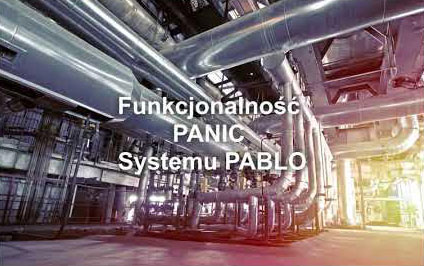Alarms
The course of an example threat incident
1.
Danger when working in the field
A lone worker performing unsupervised activities, as a result of external factors (injuries, environmental factors, e.g. gases) or changes in health status, may lose consciousness or be unable to change their position and find themselves in a life-threatening situation. Equipped with a PABLO radio, he or she can press the dedicated PANIC button to trigger an alarm. In the open area, the location of the radio is given based on the GPS position.
2.
Danger when working indoors
In indoor places where the GPS signal does not reach, such as production halls, warehouses, corridors, cellars, the PABLO System also allows the endangered employee to be assisted. By pressing the dedicated PANIC button, the employee will trigger an alarm. The location is given on the basis of the signal of radio beacons that are installed during the installation of the PABLO System.
3.
PABLO console – visualization of the incident on map
The system ALARMS about the occurrence of a threat, presents the current location of the PABLO Agent on the site map in the PABLO Console installed at the dispatcher station and / or other positions of supervisory teams. GPS LOCATION as well as in signal suppressing rooms, underground, concrete or disturbed.
4.
PABLO console – dispatcher’s post
A dispatcher or persons dedicated to supervising employees who perform tasks alone, performs a procedure prepared in the event of a specific incident, activates rescue teams and coordinates the entire action. After the crisis is over, he or she describes the course of events, leaving a permanent trace and time information about the incident that occurred.
5.
SMS notification to the GSM telephone of the crisis management team
The PABLO system automatically sends an SMS to the GSM telephone of the crisis management team. The message includes the location of the alarm and the identification number of the radio that triggered the alarm.
6.
Automatic voice communicate
The PABLO system can be integrated with an internal sound system. This allows you to send automated voice messages in the vicinity of the zone where the alarm was triggered by one of the PABLO Agents, eg “Zone 5 alarm!”. This allows for even faster, automated and more effective assistance. The victim’s colleagues can find out about the accident without the need to notify the dispatcher.
7.
COMMUNICATION – a critical link in signaling a threat
The PABLO system enables integration with Zenitel intercom systems, as a result of which the process of sending voice or sound warnings in the zone in which the hazard occurred can be automated.
8.
RESCUE operation
The PABLO system provides information not only about the location of the injured employee, but also the current location of other PABLO Agents. Thanks to this information, the factory dispatcher can actively support the crisis team with the necessary information. The most important advantage, however, is CRITICAL COMMUNICATION, which is a combination of all the advantages of the mobile, independent of the operators’ infrastructure and power supply of the PABLO System. The level of security is significantly increased by a well-thought-out communication strategy between DMR radio systems and the fixed intercom infrastructure.
9.
Closing of the INCIDENT
Coordination of the action carried out by the dispatcher leaves the necessary information in the PABLO System, i.e. the time trace and location of the incident as well as the necessary description of the course of the event. These are elements used in post-accident documentation or to keep health and safety statistics.



